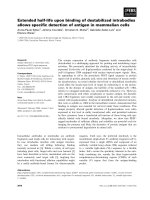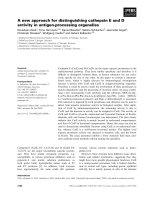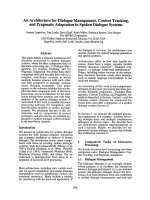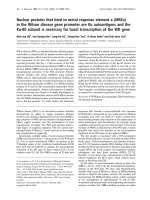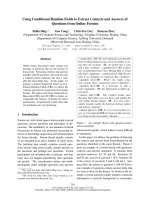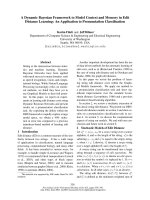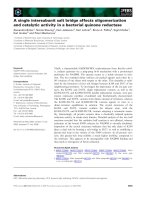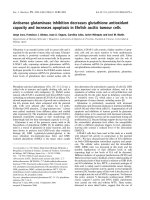báo cáo khoa học: " Years of life lost to prison: racial and gender gradients in the United States of America" pps
Bạn đang xem bản rút gọn của tài liệu. Xem và tải ngay bản đầy đủ của tài liệu tại đây (204.37 KB, 5 trang )
BioMed Central
Page 1 of 5
(page number not for citation purposes)
Harm Reduction Journal
Open Access
Research
Years of life lost to prison: racial and gender gradients in the United
States of America
Robert S Hogg*
1,2,3
, Eric F Druyts
2
, Scott Burris
5
, Ernest Drucker
4
and
Steffanie A Strathdee
2,3
Address:
1
Faculty of Health Sciences, Simon Fraser University, Burnaby, British Columbia, Canada,
2
British Columbia Centre for Excellence in HIV/
AIDS, St. Paul's Hospital, Vancouver, British Columbia, Canada,
3
Division of International Health and Cross Cultural Medicine, San Diego School
of Medicine, University of California, California, USA,
4
Montefiore Medical Center, New York, New York, USA and
5
Beasley School of Law, Temple
University, Philadelphia Pennsylvania, USA
Email: Robert S Hogg* - ; Eric F Druyts - ; Scott Burris - ;
Ernest Drucker - ; Steffanie A Strathdee -
* Corresponding author
Abstract
Background: The United States has the highest rate of imprisonment of any country in the world.
African Americans and Hispanics comprise a disproportionately large share of the prison
population. We applied a "prison life expectancy" to specify differences in exposure to
imprisonment by gender and race at the population level.
Methods: The impact of imprisonment on life expectancy in the United States was measured for
each year from 2000 to 2004, and then averaged. Using the Sullivan method, prison and prison-free
life expectancies were estimated by dividing the years lived in each age range of the life table into
these two states using prevalence of imprisonment by gender and race.
Results: African American males can expect to spend on average 3.09 years in prison or jail over
their lifetime and Hispanic and Caucasian males can spend on average 1.06 and 0.50 years,
respectively. African American females, on the other hand, can expect to spend on average 0.23
years in these institutions and Hispanic and Caucasian females can expect to spend on average 0.09
and 0.05 years, respectively. Overall, African American males, the highest risk group, can expect to
spend on average 61.80 times longer in prison or jail as compared to Caucasian women, the lowest
risk group.
Conclusion: There are clear gender and racial gradients in life expectancy spent in prison in the
United States. Future research needs to examine how current imprisonment practice in the United
States may influence population health and health disparities.
Introduction
The United States has the highest rate of incarceration in
the developed world. Nearing the end of the 1990s, over
two million people were behind bars and another four
and half million people were on probation or parole. The
number of people imprisoned almost doubled in the
1990s, increasing from one in every 218 residents in 1990
to one in every 145 in 2001 [1]. Imprisonment has not
Published: 25 January 2008
Harm Reduction Journal 2008, 5:4 doi:10.1186/1477-7517-5-4
Received: 18 May 2007
Accepted: 25 January 2008
This article is available from: />© 2008 Hogg et al; licensee BioMed Central Ltd.
This is an Open Access article distributed under the terms of the Creative Commons Attribution License ( />),
which permits unrestricted use, distribution, and reproduction in any medium, provided the original work is properly cited.
Harm Reduction Journal 2008, 5:4 />Page 2 of 5
(page number not for citation purposes)
been evenly distributed throughout the population.
Prison populations are comprised of disproportionate
numbers of African Americans and Hispanics. The life-
time probability of being imprisoned in 2001 was six
times higher for males than females – 11.3% versus 1.8%.
Among males, African Americans have a one in three
chance of being imprisoned during their lifetime, whereas
Hispanics and Caucasians have a one in six and a one in
17 chance, respectively [1,2].
Life expectancy is an essential indicator of population
health. It may be refined by techniques that assess the
quality of expected life years, such as the disability-free life
expectancy. The high rate of imprisonment in the United
States may translate to a significant proportion of time
being spent in prison, especially for certain sub-groups of
the population. If imprisonment influences life expect-
ancy, time spent in prison becomes a matter of public
health importance. The goal of the present study was to
determine the differences in the number of years of life
lost to imprisonment in the United States population by
gender and race.
Methods
The number of years of life lost to imprisonment in the
United States was measured for each year from 2000 to
2004, and then averaged for this time period. Population
data were derived from the US Census Bureau, National
Population Estimates [3], and the proportion of the total
population imprisoned at mid-year in jails and prisons
were estimated from data obtained from the US Depart-
ment of Justice for the years 2000 to 2004 [4-8]. Life tables
were obtained from US Census Bureau, National Popula-
tion Projections [9].
To provide context, rates of imprisonment and person-
years of life lost to imprisonment were first calculated.
Rates were calculated for each year, 2000 through 2004,
for the age group 18 to 44 years. Rates of imprisonment in
this age group were the average of the number of persons
in prison per 100,000 population. Person-years of life lost
to imprisonment were calculated by multiplying the
number of persons imprisoned in a specific age group by
years left to 45 years. Person years were then totaled for
each gender and racial group and expressed as person
years lost per 100,000 population.
The Sullivan method [10] was used to estimate the impact
of imprisonment on life expectancy in the United States.
Sullivan's method involves using the prevalence of health
states at each age in the current population (at a given
point of time) to divide the hypothetical years of life lived
by a period life table cohort at different ages into years
with and without disability. In our example, prison (disa-
bility) and prison-free life expectancies were estimated by
dividing the years lived in each age range of the life table
into these two states using prevalence of imprisonment by
gender and race. These figures were then used to compute
the life table value of the total remaining years of life and
the corresponding life expectancy in each state for each
age group. Total life expectancy at birth or any other age
group by race and gender was the sum of life expectancy
in the prison and prison-free states.
Results
There was on average 1.75 million persons between the
ages of 18 and 44 in prison in the United States between
2000 and 2004. The vast majority of prisoners over this
time period were male (92.5%). African American males
comprised the largest percentage of the male prison pop-
ulation (45.2%). Caucasian and Hispanic males consti-
tuted 34.3% and 18.4% of the total male prison
population, respectively. Among the female imprisoned
population, Caucasian and African American females
comprised the largest percentages (40.9% and 41.7%,
respectively) followed by Hispanic females (14.5%)
(Table 1).
Table 2 shows rates of imprisonment and person-years of
life lost to prison in the United States, 2000–2004, by race
and gender, for those aged 18–44. Rates of imprisonment
were consistently highest among African Americans for
either gender in all years. The average rate of imprison-
ment for ages 18 to 44 years ranged from 9,800 per
100,000 population in African American males to 165 per
100,000 population in Caucasian females over the time
period. African American males also consistently lost the
most person years of life between 18–44 years due to
imprisonment over this time period. The average was
nearly 140,000 years of life lost per 100,000 population
compared to 1,229 years of life lost per 100,000 popula-
tion for Caucasian females. In both males and females,
there was a consistently clear gradient with rates for His-
panics being intermediate between those of African Amer-
icans and Caucasians for all years.
Table 3 shows years of life lost to imprisonment in the
United States, 2000–2004, by race and gender. Males
spent a greater proportion of their life in prison or jail
than females. Considering either gender, African Ameri-
cans spent much more of their life imprisoned than His-
panics and Caucasians. Based on these data, African
American males can expect to spend on average 3.09 years
in prison or jail over their lifetime and Hispanic and Cau-
casian males can spend on average 1.06 and 0.50 years,
respectively. African American females, on the other hand,
can expect to spend on average 0.23 years in these institu-
tions and Hispanic and Caucasian females can expect to
spend on average 0.09 and 0.05 years, respectively. Over-
all, African American males, the highest risk group, can
Harm Reduction Journal 2008, 5:4 />Page 3 of 5
(page number not for citation purposes)
expect to spend on average 61.80 times longer in prison or
jail as compared to Caucasian women, the lowest risk
group.
Discussion
Our study contributes to evidence that the burden of
imprisonment is not evenly distributed across gender and
race in the United States population. Males spend a
greater proportion of their life in prison or jail than
females. Considering either gender, African Americans
spend much more of their life in prison or jail than His-
panics or Caucasians. The burden, if not the disparity,
would be even larger if we considered people confined
under the jurisdiction of local authorities and people that
Table 1: Number of persons in prison in the United States, 2000–2004, by race and gender, age 18–44
Year Total* Caucasian n (%) African American n (%) Hispanic n (%)
Female
2000 141,100 56,300 (39.9) 64,200 (45.5) 17,600 (12.5)
2001 146,500 60,100 (41.0) 64,200 (43.8) 18,100 (12.4)
2002 146,600 59,700 (40.7) 58,500 (39.9) 22,800 (15.6)
2003 152,500 65,100 (42.7) 58,100 (38.1) 24,800 (16.3)
2004 157,900 69,700 (44.1) 58,400 (37.0) 25,300 (16.0)
2000–2004 148,920 62,180 (41.7) 60,680 (40.9) 21,720 (14.5)
Male
2000 1,559,900 556,300 (35.7) 716,100 (45.9) 260,900 (16.7)
2001 1,592,200 578,000 (36.3) 729,600 (45.8) 257,500 (16.2)
2002 1,614,200 526,600 (32.6) 731,700 (45.3) 308,200 (19.1)
2003 1,612,000 534,800 (33.2) 719,700 (44.7) 322,000 (20.0)
2004 1,638,100 555,400 (33.9) 722,100 (44.1) 324,000 (19.8)
2000–2004 1,603,280 550,220 (34.3) 723,840 (45.2) 294,520 (18.4)
SOURCE: AJ Beck, JC Karberg. Prison and Jail Inmates at Midyear 2000, 2001, 2002, 2003, 2004.
*Includes Indians, Alaska Natives, Asians, Native Hawaiians, and other Pacific Islanders; totals for Caucasian, African American, and Hispanic will not
equal to 100 percent.
Table 2: Rates of imprisonment and person-years of life lost to prison in the United States, 2000–2004, by race and gender, age 18–44
(per 100,000 population)
Year Caucasian African American Hispanic
Rate of
imprisonment
Person-years of
life lost to Prison
Rate of
imprisonment
Person-years of
life lost to Prison
Rate of
imprisonment
Person-years of
life lost to Prison
Female
2000 152 1,983 811 10,341 225 3,186
2001 164 2,147 808 10,343 224 3,172
2002 163 2,073 732 8,898 275 3,843
2003 181 2,239 726 8,814 281 3,656
2004 165 1,738 726 8,823 289 3,917
2000–2004 165 2,036 761 9,444 260 3,555
Male
2000 1,481 19,812 9,885 141,108 2,952 44,211
2001 1,549 20,865 9,975 141,602 2,795 42,259
2002 1,420 18,836 9,887 141,929 3,212 48,094
2003 1,454 18,961 9,656 136,808 3,238 47,659
2004 1,521 19,852 9,605 136,089 3,163 46,607
2000–2004 1,485 19,665 9,800 139,507 3,078 45,766
Harm Reduction Journal 2008, 5:4 />Page 4 of 5
(page number not for citation purposes)
were on parole or probation, since the latter group is cur-
rently twice the size of those imprisoned [11]. Further-
more, the percentage of time spent in prison is
conservative in our study because the estimate of life
expectancy is from birth, even though most people who
are imprisoned are between 18 and 44 years of age.
Although data are limited, there is a growing concern that
imprisonment can have serious negative health conse-
quences [12,13]. Prison populations exhibit an elevated
prevalence of communicable disease [14]. High levels of
violence, including sexual violence, have been reported
among imprisoned populations [15,16]. Consensual sex
without condoms as well as drug injection and tattooing
without sterile equipment are reported to occur at danger-
ous levels and to result in transmission of diseases, such
as HIV [12,17-21]. Additionally, imprisonment may have
life altering health consequences mediated by factors such
as a decline in socio-economic status [22].
Our findings, and the growing literature on the negative
health consequences of imprisonment, suggest that the
extensive reliance on incarceration to control behavior in
the United States has social costs that have not been fully
recognized [22]. These social costs are not evenly distrib-
uted and may be contributing to population health dis-
parities [23]. These health consequences may be reduced
to some degree by making prisons more salubrious – by
introducing better health, addiction treatment and mental
health care, distributing condoms and needles, preventing
violence and coordinating services as inmates move back
into the community [12]. The most direct way to reduce
these consequences would be to reduce the number of
people who go to prison. One way to accomplish this
would be by reducing the number of behaviors subject to
imprisonment. Because laws criminalizing drug posses-
sion are the major driver of the imprisonment of the non-
violent offenders in the United States, changes in these
laws could be expected to have a significant impact. Other
steps would include investing more in drug treatment,
mental health care and other services that can forestall
offending, reduce recidivism or serve as alternatives to
imprisonment.
The use of mid-year sample data from the Bureau of Jus-
tice Statistics to measure the number of persons impris-
oned may represent a limitation in our analyses. These
data are based on sample estimates and do not reflect a
complete census of prisoners. We must also recognize that
these data exclude persons confined in locally adminis-
tered facilities who are under the jurisdiction of local
authorities and those who are on parole or probation [4].
Additionally, the Sullivan method does not reflect transi-
tions in and out of prison. However, regardless of prison
term or transitions in and out of prison, the potential
health consequences identified above are still of concern.
More research on the health effects of imprisonment and
new interventions to reduce them should be an urgent pri-
ority within both corrections and public health. Even in
the absence of additional data, our study suggests that
health consequences should be given greater weight in
Table 3: Years of life lost to imprisonment in the United States, 2000–2004, by race and gender
Year Caucasian African American Hispanic
Total Non-prison
component
Prison
component
Total Non-prison
component
Prison
component
Total Non-prison
component
Prison
Component
Female
2000 79.78 79.73 0.05 74.79 74.55 0.24 82.13 82.06 0.08
2001 79.89 79.84 0.05 74.98 74.74 0.24 82.13 82.06 0.07
2002 80.00 79.94 0.05 75.16 74.93 0.23 82.25 82.16 0.09
2003 80.10 80.05 0.06 75.34 75.11 0.23 82.31 82.21 0.10
2004 80.21 80.15 0.05 75.52 75.29 0.23 82.35 82.25 0.10
2000–2004 80.00 79.94 0.05 75.16 74.92 0.23 82.23 82.15 0.09
Male
2000 74.92 74.42 0.50 68.58 65.50 3.08 76.66 75.62 1.05
2001 75.02 74.50 0.52 68.76 65.73 3.04 76.66 75.72 0.94
2002 75.12 74.65 0.47 68.95 65.86 3.09 76.85 75.75 1.09
2003 75.23 74.73 0.50 69.14 66.03 3.11 76.94 75.82 1.12
2004 75.33 74.81 0.52 69.33 66.22 3.11 77.03 75.94 1.09
2000–2004 75.13 74.62 0.50 69.00 65.91 3.09 76.83 75.77 1.06
Note: Standard errors for estimates range from <0.001 to 0.003.
Publish with Bio Med Central and every
scientist can read your work free of charge
"BioMed Central will be the most significant development for
disseminating the results of biomedical research in our lifetime."
Sir Paul Nurse, Cancer Research UK
Your research papers will be:
available free of charge to the entire biomedical community
peer reviewed and published immediately upon acceptance
cited in PubMed and archived on PubMed Central
yours — you keep the copyright
Submit your manuscript here:
/>BioMedcentral
Harm Reduction Journal 2008, 5:4 />Page 5 of 5
(page number not for citation purposes)
discussions of law enforcement strategies generally and
drug policy in particular.
Competing interests
The author(s) declare that they have no competing inter-
ests.
Authors' contributions
RSH, SB, ED, and SAS initiated the study. RSH and EFD
collected and analyzed the data. All authors contributed
to the writing of the manuscript. All authors reviewed the
final manuscript for important intellectual content.
Acknowledgements
We acknowledge the support from the Michael Smith Foundation for
Health Research through a Senior Scholar Award to Dr. Hogg. Dr. Strath-
dee is supported through the foundation for the Harold Simon Chair, as
well as grants from the National Institute on Drug Abuse (DA12568,
DA14499 and DA09225). We would like to thank Justin Barer, Anna
McGuire, and Patricia Kretz for their research assistance.
References
1. Bonczar TP, Beck AJ: Lifetime likelihood of going to state or
federal prison. Washington, DC: US Department of Justice, Bureau
of Justice Statistics; 1997.
2. Bonczar TP: Prevalence of imprisonment in the US popula-
tion, 1974–2001. Washington, DC: US Department of Justice,
Bureau of Justice Statistics; 2003.
3. US Census Bureau, Population Division: National Population Esti-
mates, April 1, 2000 to July 1, 2005. [ />popest/national/asrh/NC-EST2005-asrh.html]. Accessed 14 February
2007
4. Beck AJ, Karberg JC: Prison and jail inmates at midyear 2000.
2001 [ />]. Washington,
DC, US Department of Justice, Bureau of Justice Statistics Accessed
9 February 2007.
5. Beck AJ, Karberg JC: Prison and jail inmates at midyear 2001.
2002 [ />]. Washington,
DC, US Department of Justice, Bureau of Justice Statistics Accessed
9 February 2007
6. Beck AJ, Karberg JC: Prison and jail inmates at midyear 2002.
2003 [ />]. Washington,
DC, US Department of Justice, Bureau of Justice Statistics Accessed
9 February 2007
7. Beck AJ, Karberg JC: Prison and jail inmates at midyear 2003.
2004 [ />]. Washington,
DC, US Department of Justice, Bureau of Justice Statistics Accessed
9 February 2007
8. Beck AJ, Karberg JC: Prison and jail inmates at midyear 2004.
2005 [ />]. Washington,
DC, US Department of Justice, Bureau of Justice Statistics Accessed
9 February 2007
9. US Census Bureau, Population Division: National Population Pro-
jections. [ />detail/lt99_10.a]. Accessed 15 February 2007
10. Sullivan DF: A single index of mortality and morbidity. HSMHA
Health Reports 1971, 86:347-354.
11. Department of Justice Office of Justice Programs: Correctional
Populations in the United States – Statistical Tables. 2002.
12. World Health Organization (Regional Office for Europe): WHO
Guidelines on HIV infection and AIDS in prison. HIV in pris-
ons: a reader with particular relevance to the Newly Inde-
pendent States. WHO Regional Office for Europe; 2001.
13. World Health Organization (Regional Office for Europe): Health in
Prisons Project and Pompidou Group of the Council of
Europe. Prisons, drugs and society: a consensus statement
on principles, policies and practices. Berne, WHO (Regional
Office for Europe) and the Council of Europe; 2001.
14. Hammett TM, Harmon P, Rhodes W: The burden of infectious
disease among inmates of and releasees from US correc-
tional facilities, 1997. American Journal of Public Health 2002,
92(11):1789-94.
15. Robertson JE: Rape among incarcerated men: sex, coercion
and STDs. Aids Patient Care and Stds 2003, 17(8):423-30.
16. Struckman-Johnson C, Struckman-Johnson D: Sexual coercion
reported by women in three Midwestern prisons. Journal of
Sex Research 2002, 39(3):217-27.
17. Mahon N: New York inmates' HIV risk behaviors: the implica-
tions for prevention policy and programs. American Journal of
Public Health 1996, 86(9):1211-5.
18. Mutter RC, Grimes RM, Labarthe D: Evidence of intraprison
spread of HIV-infection. Archives of Internal Medicine 1994,
154(7):793-5.
19. Krebs CP, Simmons M: Intraprison HIV transmission: as assess-
ment of whether it occurs, how it occurs, and who is at risk.
AIDS Education & Prevention 2002, 2(5):363-367.
20. Brewer TF, Vlahov D, Taylor E, Hall D, Munoz A, Polk BF: Transmis-
sion of HIV-1 within a statewide prison system. AIDS 1988,
2(5):363-7.
21. Choopanya K, Des Jarlais DC, Vanichseni S, Kitayaporn D, Mock PA,
Raktham S, Hireanras K, Heyward WL, Sujarita S, Mastro TD: Incar-
ceration and risk for HIV infection among injection drug
users in Bangkok. Journal of Acquired Immune Deficiency Syndromes
2002,
29(1):86-94.
22. Iguchi MY, London JA, Forge NG, Hickman L, Fain T, Riehman K: Ele-
ments of well-being affected by criminalizing the drug user.
Public Health Reports 2002, 117(Supplement 1):S146-S150.
23. Freudenberg N: Jails, prisons, and the health of urban popula-
tions: a review of the impact of the correctional system on
community health. Journal of Urban Health 2001, 78(2):214-35.
